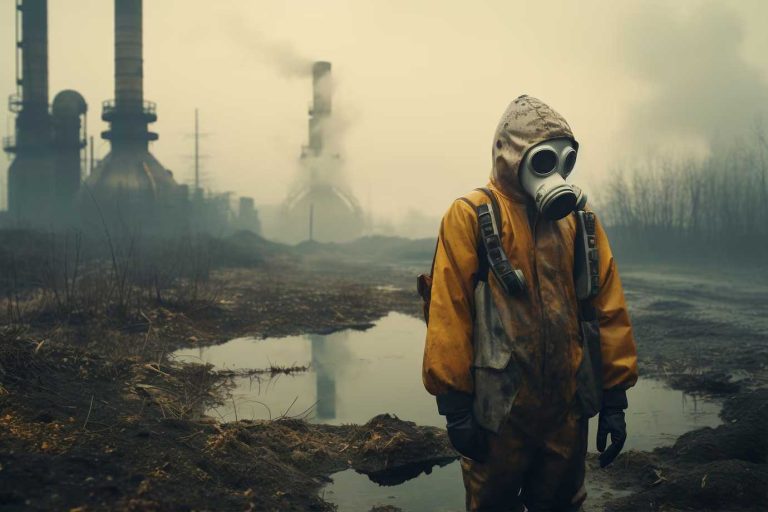There are many toxins in the modern world that can hurt our health and well-being. These chemicals, which are sometimes called “harmful environmental chemicals,” can be found in the water we drink, the air we breathe, and the things we use every day. Understanding the nature of these harmful chemicals to the environment and how they affect human health is important for making smart decisions and fighting for a better world.
What are Environmental Chemicals?
Environmental chemicals are chemicals that get into the world from factories, farms, and everyday goods that people use. There are a lot of different poisons that are released into the world. In this group of chemicals are pesticides, heavy metals, phthalates, polychlorinated biphenyls (PCBs), and volatile organic compounds (VOCs). Many more and higher concentrations of some substances have been found in the world because of things people have done. Even though some of these chemicals can be found in nature, this is still the case.
Sources of Toxic Environmental Chemicals
- Industrial Emissions: Besides harming the land, water, and air, factories and other industrial operations release many dangerous chemicals into the environment. These toxins include sulfur dioxide, nitrogen oxides, benzene, and formaldehyde, just to name a few. Being expose to these chemicals for a long time could cause a number of serious health problems, such as cancer and breathing issues.
- Agricultural Chemicals: Many harmful chemicals end up in the environment when farmers use a lot of pesticides and fertilizers while farming. Glyphosate, atrazine, and organophosphates are some of these chemicals. This kind of chemical can get into waterways and food sources and make them dirty, which is very bad for people and animals’ health.
- Household Products: Phthalates, parabens, and bisphenol A (BPA) are all chemicals that you can find in plastics, cleaning goods, and personal care items. People already know this to be true. Not only do these chemicals mess up the endocrine system, they can also get into the water and air, which could cause a number of other health issues.
- Waste Management: When dangerous trash like medicines and old electronics is thrown away in the wrong way, it can release harmful chemicals into the environment. Most of the time, these toxins come from places like incinerators and landfills.
Health Effects of Harmful Environmental Chemicals
When people are expose to harmful chemicals in the world, it can hurt their health in many different ways. Some of the things that affect these effects are the type of drug, the amount of contact, and how sensitive the person is. The following are some of the most worrying effects on health:
1. Respiratory Issues
Particulate matter, volatile organic compounds (VOCs), and ozone are some of the chemicals that can affect the respiratory system. This can lead to asthma, chronic bronchitis, and less lung function. Exposure for a long time may also raise the risk of getting lung cancer.
2. Endocrine Disruption
Several other chemicals, besides phthalates and bisphenol A (BPA), are known to hurt the endocrine system. Changing the way hormones normally work can have many bad effects, such as making it harder to get pregnant, having problems with growth, and raising the risk of getting some cancers.
3. Neurological Damage
Lead, mercury, and PCBs are some examples of neurotoxic chemicals that can hurt both the growth and function of the brain. As a result, this could lead to problems with thinking and behavior, as well as a higher risk of getting neurological diseases like Parkinson’s and Alzheimer’s.
4. Carcinogenic Effects
Several health groups have said that a number of substances found in the surroundings can cause cancer. Long-term exposure to chemicals like benzene, formaldehyde, and asbestos may raise the risk of getting a number of cancers, such as leukemia, liver cancer, and mesothelioma.
5. Immune System Suppression
Some chemicals, like dioxins and PCBs, can weaken the immune system. This makes the body more likely to get sick or acquire an infection. Because this affect weakens the immune system, vaccines may not work as well as they would otherwise.
Mitigating the Impact of Toxic Environmental Chemicals
1. Regulatory Measures
Governments and regulatory bodies have the very important job of keeping dangerous chemicals from getting into the world. The Clean Air Act, the Safe Drinking Water Act, and the Toxic Substances Control Act are all laws that were create to protect public health and lower human exposure to harmful substances. There needs to be constant pushing for stricter rules and stricter implementation.
2. Sustainable Practices
Using safe methods in business, farming, and everyday life could greatly reduce the release of harmful chemicals. This can be see in the use of things that are good for the earth, the use of clean farming methods, and the growing dependence on fossil fuels.
3. Public Awareness and Education
It is possible to give people the tools they need to make healthy decisions by teaching them more about the dangers of environmental chemicals and how to protect the environment safely. There is a chance that neighborhood projects and public health efforts can help people lower their exposure and make their surroundings safer.
4. Research and Innovation
Putting money into study and new ideas is important if we want to make new technologies and methods that can find, control, and lessen the effects of dangerous chemicals. This includes progress in science that is better for the environment, technology for reducing waste, and new materials that are better for the environment.
Conclusion
Harmful chemicals are found in large amounts in the environment, which is very bad for both people and the environment. It is important to know where these dangerous substances come from and what effects they have, but it is also important to take steps to avoid them and make the world safer. We can lessen the effects of poisonous chemicals and protect future generations by putting in place rules, switching to environmentally friendly methods, raising public knowledge, and spending money on research.
